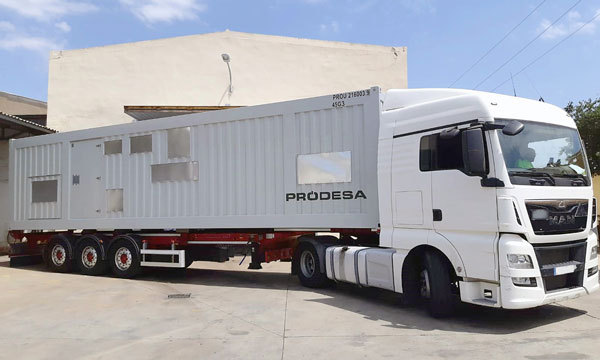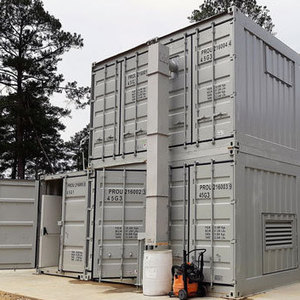Thinking Inside the Box







PHOTO: PRODESA
November 30, 2021
BY Anna Simet
Strategic location is a critical component for wood pellet operations, especially those with business models based solely or primarily on wood pellet production. The more accessible fiber, the better—more options, less risk. But what if that risk could be reduced even further via the ability to relocate if fiber streams dissipated?
That’s precisely the idea behind PelletBox, Prodesa’s containerized pellet plant concept. Debuting in in 2019, the compact, modular pellet plant is being deployed in numerous U.S. locations, according to Mike Curci, Prodesa capital equipment sales manager. This includes Drax’s three 40,000-ton-per-year satellite plants under development in Arkansas, two of which have undergone assembly.
The journey from fabrication to arrival on-site demonstrates the mobile nature of the units, with the origin being the company’s headquarters in Zaragoza, Spain. “We manufacture them in our production facility there, using certified sea containers,” Curci says. “We then test run them, from running all the cabling to ensuring motors are running properly. Once that’s done, we spool wires back up, uncouple conveyors, replace panels removed as part of assembly, and then we truck them out to the port.”
From there, they are loaded on to a boat and shipped to the customer. Meanwhile, that customer is laying out civil work—a 60-square-meter concrete platform is required. “Once delivered, we can stack up the complete units in a single day and assemble rather quickly,” Curci says. “It drastically reduces the cost of a single pellet mill type of facility.”
It also reduces the number of companies and contractors on-site. “We or the owner will hire a local millwright group, but they’re just reconnecting wires and conveyors,” Curci says. “From there, we really only need to determine how material will enter the system, and then what will be done with the pellets when they come out. We handle everything from the inlet to discharge, and can engineer a frontloading system or silo to handle the finished pellets at the site.”
Compact Components
A Pelletbox unit consists of five shipping containers—four 40-foot containers, and one 20-foot container for the electrical components. The five-ton-per-hour system is compatible with dry material including chips, sawdust and shavings and includes stages of grinding and pelletizing. Inside the containerized units, major components include a destoner, filtration system, hammer mill, pellet mill and feeding hopper, pellet screen, screw conveyor and cooling system. Electrical installed power is 745 kilowatts.
Curci notes that Prodesa does have the ability to make some design changes—for example, a customer with material that doesn’t require grinding. ‘We can reduce or remove the hammermill portion,” he says. “So that would reduce cost. We have a couple different configurations in terms of layout and where we put the MCC (motor control center) building with platforms.”
In the example of Drax, all three facilities will be the same, thus reducing engineering cost and simplifying manufacturing. “For groups that have multiple installations, we also have the commonality of spare parts—this reduces the amount of inventory that they or we keep on the shelf,” Curci says.
He emphasizes that though the compact design is meant to be part of the allure, the systems are by no means limited to small-scale operations. “We have one commercial-scale plant with 18 in its facility. It’s the same machinery used in large-scale units—it’s not a small production. It’s an industrial-sized, 500-horsepower pellet mill that we’ve been able to containerize to reduce the cost of entry into the marketplace for those looking to get into the pellet industry.”
Boxed Benefits
Out of PelletBox’s intended benefits, Curci emphasizes the ease of transport. “They are very easy to move and install,” he says. “For example, if one is colocated with a sawmill but then later the sawmill shuts down, it can be picked up and relocated to take advantage of other residuals or fiber. It minimizes the risk, particularly in emerging markets in other countries. And even here in North America at sawmills and pallet recycling facilities—many are getting into the pellet space, if they are leasing the building and need to relocate, we can do that.”
And for those new to the industry, Prodesa provides the education necessary to run these facilities. “We start at the theory of size reduction, and we walk through the startup operations, the maintenance troubleshooting, all the way through the entire process,” he says. “By time we’re done with the training program, they’re able to operate that facility and have knowledge for other facilities as well. We’re really trying to drive education, especially ensuring the safety aspect is hit on hard during training programs—not only with PelletBox, but other facilities, too. For these sawmills waiting to get into this, we want to provide them with a very safe and reliable operation. This system already has fire protection in it and is heavily engineered with safety in mind.”
The COVID-19 epidemic has not had an impact on business, Curci adds. “There has been a lot of activity—especially a flurry in the North American market. It’s very exciting.”
Author: Anna Simet
Editor, Pellet Mill Magazine
asimet@bbiinternational.com
701-738-4961
Advertisement
Advertisement
Advertisement
Advertisement
Upcoming Events





